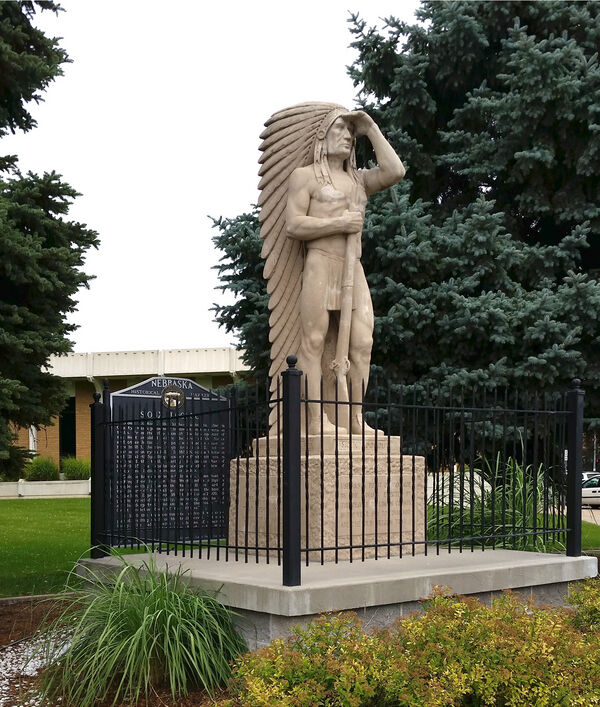Difference between revisions of "Nebraska Historical Marker: Sioux Lookout"
(Created page with "[[Image:________ |thumb|center|upright=3.0|alt=________]] ==Location== 2601-2613 N Buffalo Bill Ave, North Platte, Lincoln County, Nebraska View this marker's location '''[h...") |
|||
| (3 intermediate revisions by 2 users not shown) | |||
| Line 1: | Line 1: | ||
| − | [[ | + | [[File:NHM_089_01_01SiouxLookout.jpg |thumb|center|upright=3.0|alt=NHM_089_01_01SiouxLookout.jpg]] |
==Location== | ==Location== | ||
| − | + | County Courthouse Square, North Platte, Lincoln County, Nebraska | |
| − | View this marker's location '''[https:// | + | View this marker's location '''[https://www.google.com/maps/place/41%C2%B008'08.3%22N+100%C2%B045'44.8%22W/@41.135628,-100.7631896,287m/data=!3m2!1e3!4b1!4m5!3m4!1s0x0:0x0!8m2!3d41.135628!4d-100.762454?hl=en 41.135628, -100.762454]''' |
| − | + | {{Marker:Map}} | |
==Marker Text== | ==Marker Text== | ||
''Sioux Lookout, the highest point in Lincoln County, was a prominent landmark on the overland trials. From its lofty summit the development of the West unfolded before the eyes of the Sioux and other Indians. Trappers and traders came by here in 1813, the first wagon train in 1830, and the first missionary in 1834. In 1836 Narcissa Whitman and Elizabeth Spalding became the first white women to travel the trail. During the Indian War of 1864-1865, its prominence gave a clear view of troop and Indian movements below. | ''Sioux Lookout, the highest point in Lincoln County, was a prominent landmark on the overland trials. From its lofty summit the development of the West unfolded before the eyes of the Sioux and other Indians. Trappers and traders came by here in 1813, the first wagon train in 1830, and the first missionary in 1834. In 1836 Narcissa Whitman and Elizabeth Spalding became the first white women to travel the trail. During the Indian War of 1864-1865, its prominence gave a clear view of troop and Indian movements below. | ||
| + | |||
''Gold seekers enroute to California, homesteaders seeking free land in the West and a religious people seeking a haven in Utah--all are part of the history of this valley. Here echoed the hooves of the Pony Express. From 1840 to 1866 some 2,500,000 people traveled the valley, engraving into the sod a wide, deep trail. Indians called the route "The Great Medicine Road of the Whites." In 1869 the transcontinental railroad was completed, ending much of the trail travel. Yet even today, the valley with its ribbons of concrete remains the Great Platte River Road to the West. | ''Gold seekers enroute to California, homesteaders seeking free land in the West and a religious people seeking a haven in Utah--all are part of the history of this valley. Here echoed the hooves of the Pony Express. From 1840 to 1866 some 2,500,000 people traveled the valley, engraving into the sod a wide, deep trail. Indians called the route "The Great Medicine Road of the Whites." In 1869 the transcontinental railroad was completed, ending much of the trail travel. Yet even today, the valley with its ribbons of concrete remains the Great Platte River Road to the West. | ||
| Line 15: | Line 16: | ||
==Bibliography== | ==Bibliography== | ||
| − | + | : Donald F Danker, “The Influence of Transportation upon Nebraska Territory,” Nebraska History 47 (1966): 187-208 | |
| − | + | {{Marker:Program}} | |
| − | + | ||
Latest revision as of 12:18, 20 September 2017
Location
County Courthouse Square, North Platte, Lincoln County, Nebraska
View this marker's location 41.135628, -100.762454
View a map of all Nebraska historical markers, Browse Historical Marker Map
Marker Text
Sioux Lookout, the highest point in Lincoln County, was a prominent landmark on the overland trials. From its lofty summit the development of the West unfolded before the eyes of the Sioux and other Indians. Trappers and traders came by here in 1813, the first wagon train in 1830, and the first missionary in 1834. In 1836 Narcissa Whitman and Elizabeth Spalding became the first white women to travel the trail. During the Indian War of 1864-1865, its prominence gave a clear view of troop and Indian movements below.
Gold seekers enroute to California, homesteaders seeking free land in the West and a religious people seeking a haven in Utah--all are part of the history of this valley. Here echoed the hooves of the Pony Express. From 1840 to 1866 some 2,500,000 people traveled the valley, engraving into the sod a wide, deep trail. Indians called the route "The Great Medicine Road of the Whites." In 1869 the transcontinental railroad was completed, ending much of the trail travel. Yet even today, the valley with its ribbons of concrete remains the Great Platte River Road to the West.
Further Information
Bibliography
- Donald F Danker, “The Influence of Transportation upon Nebraska Territory,” Nebraska History 47 (1966): 187-208
Marker program
See Nebraska Historical Marker Program for more information.
